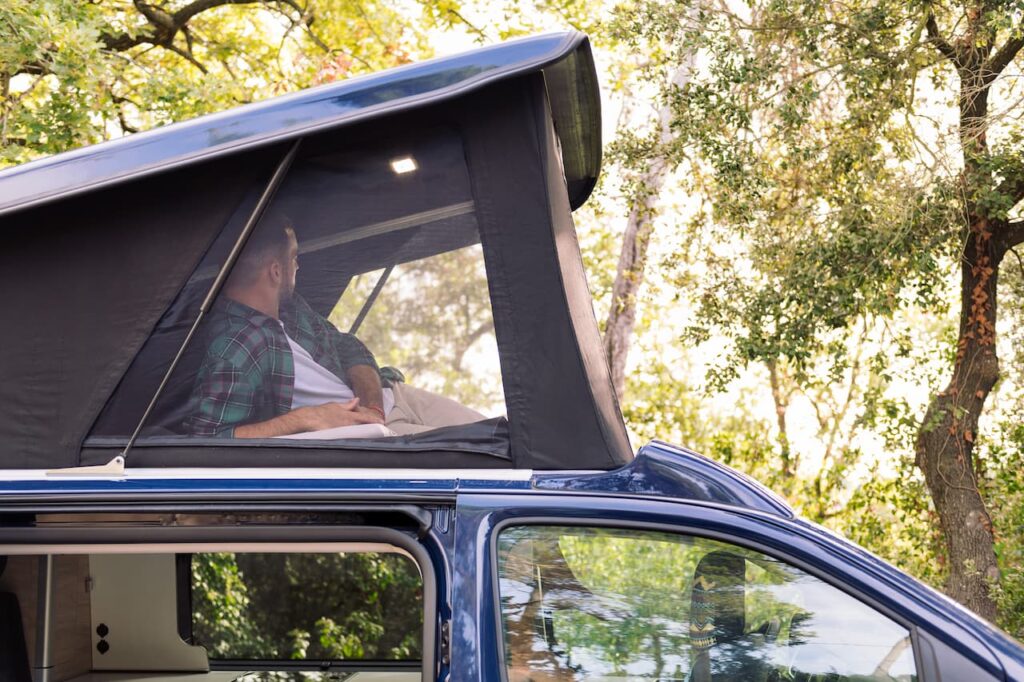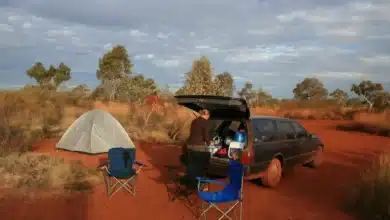The simple pop-top roof is a great way to transform camping. Pop-top Roofs for Camper allow you to travel in a flexible camper with plenty of space. Find out everything you need to know about pop-up roofs.
Although (or because?) This blog post is a bit dry, but we start it with a romantic idea: you can sleep as close to the stars as possible while camping. It’s even possible with a pop-top! This is a cool way to turn a small campervan on wheels into a home with two floors. Pop-up roofs allow for more space, headroom, and sleeping area in the camper. There are different types of pop-top roofs. What are their advantages and disadvantages? Does it make sense to retrofit a pop-top? What can you do when you encounter problems with your pop-up roof? Here you will find the answers to these questions.
The Camper Pop-Top Roof
Start at the beginning. A pop-top is a special type of roof that is used for motorhomes and campers. It is made from tent fabric, and it can be raised or opened when the vehicle is stationary to gain more space. You can then stand up in the vehicle. If a roof-bed is integrated into the pop-top roof, this can also provide additional sleeping space. Pop-top roofs are available on some camper van models as standard equipment. If not, these can be retrofitted. Pop-up roofs are often found on camper vans and even smaller motorhomes.
Did you know, in 1950, British car manufacturer Vauxhall already had a pop-up roof on its legendary Bedford CA van? You should use your search engine to find this cool vehicle.

Different Types of Pop-up Roofs
Pop-up roofs offer extra headroom and sleeping space in rooftop tents and campervans. There are many different styles, including elevated roofs and hardshell, softshell and wedge styles. Each is designed to fit different vehicle types and travel needs.
The Classic Pop-top Roofing
Many camper vans are now equipped with the classic pop-top. The pop-top is different in that only one side is raised. This creates a triangular shape. There are different types of pop-top roofs. The most common is a roof that faces forward, so you can sleep “in the direction of the travel”, or a roof facing backward. It depends mainly on the layout of your camper. If you have a rear kitchen, it’s more practical to have the roof pop up backwards to give yourself more space to cook in the back of the vehicle. A pop-top that opens in the front is more practical if the cooking area of the camper is located at the front. The side-opening roofs have become less common, partly because the tent below would be more exposed to the weather.
The Roof Can be Raised
A pop-top is similar to a traditional pop-up, but it is set vertically. It is not attached to the front or back of the vehicle, unlike the classic pop-up. The lifting roof is rarely used as a sleeping area. They also provide additional headroom for the living and cooking area. They are also great for campers with limited space.
The Roof is High
A high roof, unlike the other two options, is permanently installed on the camper. This allows for more space, including storage and sleeping areas. It is more insulated and better suited to long trips with more luggage or vacations in colder regions. However, the increased air resistance increases fuel consumption. High-roof campers, such as our favourite California (VW Grand California), are perfect for long trips or vacations to colder areas.
Benefits of a Camper with a Pop-top Roof
What makes pop-top roofing so great and practical? Here are the benefits in a nutshell:
Extra sleeping space
A pop-up roof provides more sleeping space, which is the biggest benefit. The number of people that can sleep directly doubles when there are two sleeping options. Pop-top campers, for instance, can easily accommodate a family of 4, as the roof bed works well for children.
The Camper Offers More Space and Comfort
Pop-top roofs also provide more headroom and movement space, which makes it more comfortable to remain in the lower portion of the camper. Being able to cook or change in the camper while standing upright is a game-changer.
Vehicle Height Barely Changes
It’s great that you can use the extra space only when you want to. When you don’t, it disappears. Your camper will remain low and streamlined when the pop-top is closed. It is just a few centimetres taller than it would have been without the roof. It is also very practical, as your camper can still be parked in an underground or garage. You don’t need to worry about the height when you are looking for parking spaces.
Lower Fuel Consumption
Your camper will be more aerodynamic and use less fuel when the pop-top is folded. Both the environment and your pocketbook will be happy.
Better Ventilation
Most pop-tops have windows or ventilation slots that help the air circulate in the vehicle. Many pop-top roofs come with a mosquito net that keeps midges and other insects out.

Enjoy the View
Pop-top roofs, at least those with windows, offer a unique outdoor experience, as they make you feel more “outside”. You’ve probably heard about the closeness to the stars, but the convertible roof tent also allows you to enjoy an all-around view and take in the scenery in scenic areas. Here’s an example:
The Disadvantages of a Camper with a Pop-top Roof
A camper with a roof that pops up is not suitable for every purpose. There are some disadvantages to consider:
Winter Camping with Pop-top Roof
The fabric of the foldable walls on the pop-top roof is less thermally insulating than the fixed walls inside the camper. Warm air can escape quickly through it. This is something to keep in mind when you travel to colder areas or during cold seasons. There is a simple solution, though, as you can also be prepared for cold temperatures with the use of covers or caps that fit over your pop-top. The fabric hoods can be pulled over the top of the pop-up roof. The tent is then insulated by the air layer created between the cover and the tent. This can be a good way to provide thermal insulation. The cover keeps rain off the bellows of the tent, which helps keep the pop-up top dry. You can buy this type of tent insulation from us directly when you rent with your rental.
Weather and the Environment
You are exposed to more weather conditions when you have a roof tent on your camper. Roof tents can be uncomfortable when there are strong winds or heavy rain. If the roof becomes wet, it should be dried as quickly as possible. Otherwise, the fabric may start to grow mould.
Burglary is a Risk
A pop-top is “only” a tent fabric, and it has easy-to-access windows. This can increase the risk of theft if your camper is left unattended. This can be avoided easily by closing the pop-top when you’re not around.
Retrofitting Costs
You will incur costs if you want to retrofit your camper with a pop-up roof. This is especially true if the conversion is carried out by professionals instead of you. This investment will be a personal decision.
Retrofitting an Old Pop-top Roof is Worth it.
Retrofitting a pop-top to a camper that does not come with one is possible. This upgrade is a great idea if you have a camper that no longer has enough room. Even though professional installation at a workshop costs up to EUR5,000, the cost is significantly less than purchasing a larger, new camper. A well-installed roof can also increase the value of your camper. Customising your camper to make it your dream camper can be a lot of fun.
SCA and Reimo are well-known manufacturers who offer pop-tops that can be retrofitted. They have a range of roofs for all campers from Citroen to Toyota, Fiat, Ford and Mercedes-Benz. Conversion work takes between 2 and 6 days. The process is so complex that only a few German car manufacturers, like SCA Service, can carry it out.
This is done by cutting out the roof of the camper to the exact size. It requires dexterity because, if it is a bit too big, water may enter the vehicle. The pop-up is then fitted after the roof frame has been installed. Air flaps, power connections, etc. Also installed are air flaps, power connections, etc. The flap that separates the pop-up from the interior is installed last. The installation of a pop-up roof can interfere with the structure of your camper. However, this does not mean that you should be concerned about safety.
Some campers who are highly skilled may dare to retrofit their camper. We recommend you hire an expert to carry out this conversion, which is not completely safe. This will help avoid any problems or mistakes. Always have an expert check the construction.

How to Install the Pop-up Roof on a Camper Van?
Some models, like the Ocean, can have the pop-top raised by an automatic electric drive. This is done with just a click on the computer. Other models, such as our Palermo (Mercedes Marco Polo ), require muscle power to raise the roof. Gas struts are used to hold the roof in place. Pop-up roofs for campervans can also be raised and lowered by a crank. Thanks to a clever folding mechanism, these methods don’t create the mess you would expect. The tent fabric folds automatically inwards as the tent roof closes.
Solutions to Common Problems with the Pop-top Roof of a Camper
Pop-top roofs on campers are flexible, but can also develop problems over time, such as water leaks, fabric tears or failures of the lifting mechanism. Most of these issues can be resolved with timely maintenance and proper repairs to keep your camper’s roof reliable and functional.
Ocean – VW California Ocean, Pop-top Roof Cannot be Opened or Closed.
You can solve this problem by using two simple methods.
- Start the car and drive for a maximum distance of 50 metres at a maximum speed of 20 km/h. Try again. You can also pull the four 25-amp fuses located at the bottom of the steering wheel to restart the camper system if this doesn’t work.
- After 10 minutes, you can reconnect the fuse and the roof will close or open.
- Before changing fuses, remove the ignition key from the ignition lock and turn off the lights and any other electrical consumers. This will prevent damage to your vehicle’s electrical system. Fuse boxes that are left open must be kept clean and dry. The electrical system can be damaged by dirt and moisture that enter the fuse box.
Palermo: Mercedes Marco Polo pop-top Roof cannot be closed
Occasionally, the pop-up top of the Palermo can no longer be closed. Don’t worry: this is a Mercedes safety feature. Here’s the best thing to do:
- The gas strut can be pushed back into position with a hand motion and then clicked into place. Alternatively, you can press the button labelled “Push” on the pop-up top.
- The roof should now be easy to retract.
Algarve Mooveo 700: Problems with the Drop-down Beds
You can adjust the fold-down mattress in our Algarve motorhome 700 by turning the key. The control element is located in the small cabinet next to the entry door. Follow the steps below if the drop-down mattress cannot be raised or lowered.
- Make sure the main power switch and the equipment switch are both on. The onboard computer is located next to the entry area.
- Check to see if anything is jammed underneath the bed, which could block movement.
- Check that the limit switch is firmly wedged into the silver rail at the ceiling’s top.
- The bed should now move as normal.
The Seal on the Pop-up Roofing is Loose
It can sometimes happen that the seal of the roof tent becomes loose. At first, this isn’t a big problem. If it keeps coming loose, you should visit a shop. They can tighten it again with a special tool.
Conclusion
A pop-top roof on a campervan has many benefits, including extra space, comfort, and a variety of uses. A camper van with a pop-top is perfect for campers looking for an incredibly flexible camping experience. It’s also great for people who like to sleep under the stars.
Pop-top roofs are the perfect way to explore new places!



